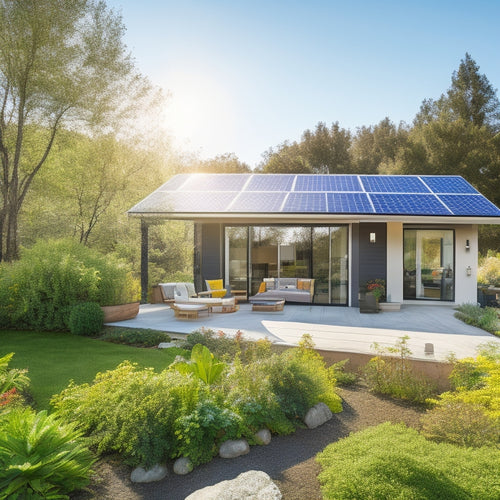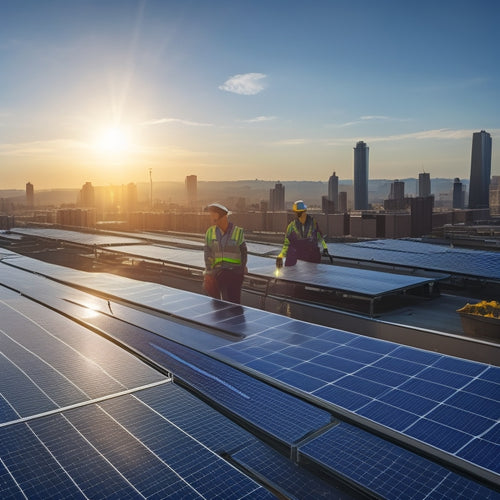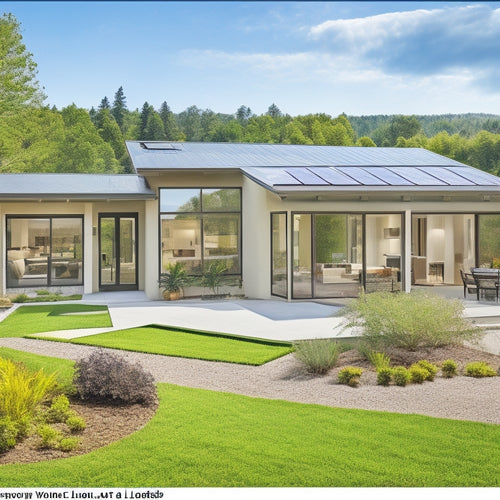
Commercial Buildings That Have Successfully Integrated Solar Panels
Share
You've probably heard of companies like Google, Amazon, and Walmart, but did you know they've successfully integrated massive solar arrays on their rooftops and parking lots, generating enough electricity to power thousands of homes? These giants have saved up to 50% on energy bills and made a strong case for environmental sustainability. Community solar gardens even offer shared benefits, increasing accessibility. Innovative installations, like solar panel facades, reduce construction costs while improving energy efficiency. As you investigate commercial buildings that have successfully integrated solar panels, you'll uncover more examples of how companies are utilizing the power of solar energy to drive their sustainable futures forward.
Key Takeaways
- Companies like Google, Amazon, and Walmart have successfully integrated solar panels, generating electricity for thousands of homes and saving up to 50% on energy bills.
- Innovative solar panel installations, such as solar panel facades and integrated approaches, can reduce construction costs and improve energy efficiency.
- Commercial solar installations can provide a strong business case for environmental sustainability, future-proofing businesses against rising energy costs and regulations.
- Power purchase agreements and flexible financing options make it easier for commercial buildings to adopt solar technologies and reduce upfront costs.
- Successful integration of solar panels in commercial buildings can increase property value by 10-15% and attract premium tenants.
Notable Examples of Solar Adoption
As you explore the commercial sector's shift towards renewable energy, several notable examples of solar adoption stand out. You'll find that companies like Google, Amazon, and Walmart are leading the charge by investing heavily in solar energy.
These corporate giants are installing massive solar arrays on their rooftops and in their parking lots, generating enough electricity to power thousands of homes.
These commercial solar installations not only reduce greenhouse gas emissions but also provide a significant return on investment. According to a recent report, commercial solar installations can save businesses up to 50% on their energy bills.
Additionally, community initiatives and residential solar programs are also gaining traction. For instance, community solar gardens allow multiple individuals or organizations to share the benefits of a single solar array, making solar energy more accessible to the masses.
As you further investigate the world of commercial solar adoption, you'll find that the benefits extend far beyond the environment, offering a strong business case for going green.
Innovative Solar Panel Installations
What can you do when traditional rooftop or parking lot solar installations won't cut it? You need to think outside the box - or in this case, the building envelope. Innovative solar panel installations offer a solution. They're not limited by conventional constraints, and they can be customized to your building's unique needs.
Consider solar panel facades, for instance. They're not just visually striking; they also provide additional structural support and insulation. This integrated approach can reduce construction costs and enhance solar panel aesthetics.
Additionally, innovative financing options, such as power purchase agreements (PPAs), can help offset upfront costs. With a PPA, you can lock in a fixed energy rate, reducing your energy expenditure and mitigating price volatility.
Green Buildings in Urban Landscapes
Your urban setting is likely home to a mix of old and new buildings, but have you stopped to reflect on their environmental impact? As you traverse the concrete jungle, it's crucial to examine the role these structures play in urban sustainability.
Green buildings, in particular, are revolutionizing urban environments by minimizing their carbon footprint. By incorporating green design, commercial buildings can reduce energy consumption by up to 30% and greenhouse gas emissions by 40%.
These eco-friendly structures also improve indoor air quality, enhance natural light, and promote occupant well-being. Additionally, green buildings can increase property value by 10-15% and attract tenants willing to pay a premium for sustainable spaces.
Cities like Singapore and Vancouver are leading the charge in urban sustainability, with green buildings accounting for over 20% of new constructions. As you look around your urban surroundings, imagine the potential impact of widespread green design adoption.
It's time to rethink the way we design and build, prioritizing sustainability and environmental stewardship in our urban environments.
Solar Power in Industrial Settings
Commercial buildings with solar panels are becoming increasingly common, and for good reason. You're likely aware of the environmental benefits, but did you know that solar power can also greatly reduce energy costs for industrial applications?
By integrating solar panels into your industrial facility, you can:
-
Reduce your reliance on non-renewable energy sources, minimizing your carbon footprint and contributing to a cleaner environment
-
Take advantage of substantial cost savings on your energy bills, freeing up resources for other essential areas of your business
-
Increase your energy efficiency, ensuring that your operations run smoothly and efficiently
-
Enhance your brand reputation by demonstrating a commitment to sustainability and environmental responsibility
-
Future-proof your business against rising energy costs and potential regulatory changes
In industrial settings, energy efficiency is vital for maintaining productivity and reducing costs. By utilizing the power of solar energy, you can optimize your operations, reduce your environmental impact, and stay ahead of the competition.
Pioneering Companies in Sustainability
Their commitment to sustainability sets them apart, and trailblazing companies are leading the charge in industrial solar adoption. You're likely familiar with companies like Apple, Amazon, and Google, which have made remarkable advancements in integrating solar power into their operations.
These companies have incorporated sustainable practices into their business models, recognizing the long-term benefits of reducing their carbon footprint. By investing in solar energy, these companies haven't only reduced their energy costs but also demonstrated their commitment to corporate responsibility.
According to the Solar Energy Industries Association (SEIA), the top 10 corporate solar users in the US have installed over 1.5 gigawatts of solar capacity, enough to power over 200,000 homes. This considerable investment in solar energy has led to a reduction of over 1.4 million metric tons of CO2 emissions annually, equivalent to taking over 280,000 cars off the road.
As you investigate the world of commercial buildings with solar panels, you'll notice that these trailblazing companies are forging the path for a more sustainable future. Their commitment to sustainable practices has set a new standard for corporate responsibility, and their investment in solar energy is driving innovation and growth in the industry.
Frequently Asked Questions
How Do Solar Panels Affect the Building's Architectural Aesthetic?
You're likely wondering how solar panels impact a building's look; the good news is that thoughtful design integration can create a seamless blend of sustainable aesthetics, enhancing your property's value and appeal while reducing its carbon footprint.
Can Solar Panels Be Installed on Old or Historic Buildings?
You might think old or historic buildings can't accommodate solar panels, but you're wrong! With careful planning, you can overcome retrofit challenges and adhere to preservation guidelines, ensuring a seamless integration that respects the building's heritage while utilizing renewable energy.
What Is the Average Payback Period for Solar Panel Investment?
You'll see a payback period of around 5-7 years for your solar panel investment, thanks to financial incentives and significant energy savings, which can add up to $400-$1,000 annually, making your eco-friendly move a smart business decision.
Do Solar Panels Require Special Maintenance or Cleaning?
You'll be surprised to know that dust and debris can reduce solar panel efficiency by up to 25%! To maximize your ROI, you should clean your panels every 6-12 months to maintain their 30-year lifespan, ensuring ideal energy output.
Can Solar Panels Be Used to Power Building's Electric Vehicle Charging Stations?
You can power your building's electric vehicle charging stations with solar panels, leveraging solar charging for a sustainable energy solution that reduces your carbon footprint and dependence on the grid, while also providing a reliable, data-driven charging experience.
Conclusion
As you've seen, commercial buildings are embracing solar power in innovative ways. From sleek rooftop installations to sprawling industrial arrays, these pioneers are redefining what's possible. Did you know that, according to the International Renewable Energy Agency, the global solar market is expected to reach 14 terawatts by 2030? That's a whopping 20-fold increase from 2019! With solar adoption accelerating, it's clear that a sustainable future is within our grasp.
Related Posts
-

Green Home Improvements Using Solar Power
Investing in solar power alters your home into a sustainable haven while slashing energy costs. You can greatly reduc...
-

Solar Installation Guide for Commercial Properties
Implementing solar energy solutions in your commercial property can lead to significant long-term savings and sustain...
-

Passive Solar Design Strategies for Homes
To effectively implement passive solar design strategies in your home, focus on ideal building orientation and strate...


